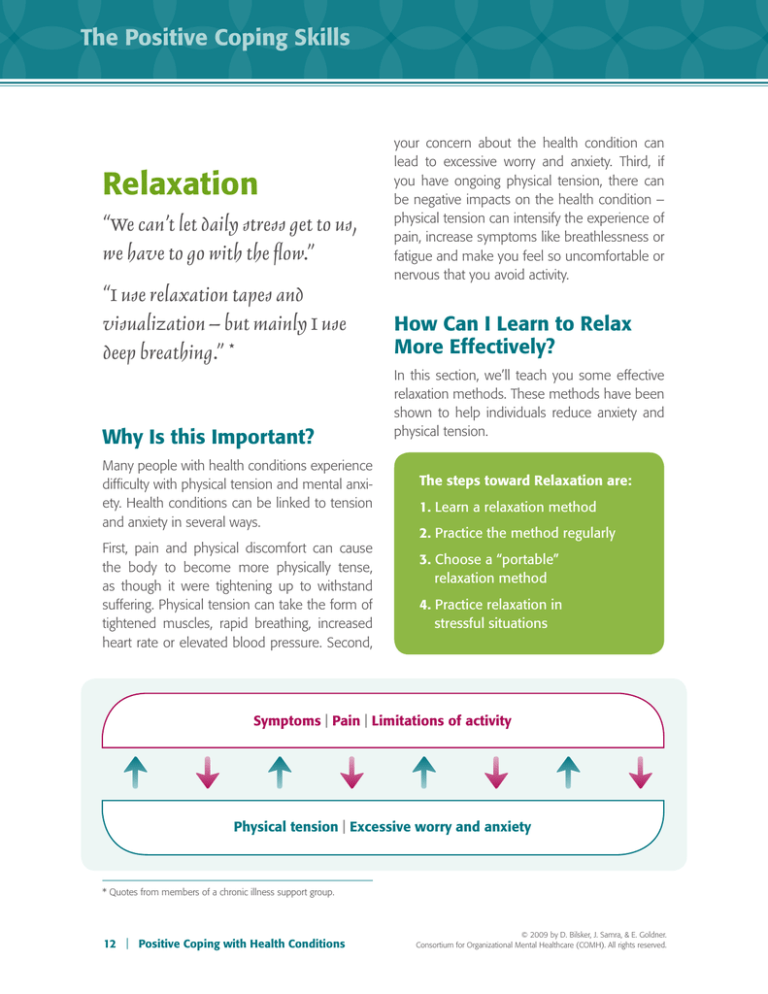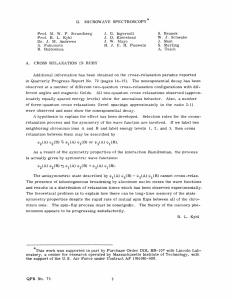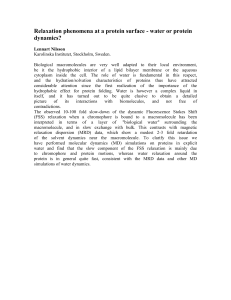
The Positive Coping Skills
Relaxation
“We can’t let daily stress get to us,
we have to go with the flow.”
“I use relaxation tapes and
visualization – but mainly I use
deep breathing.” *
Why Is this Important?
Many people with health conditions experience
difficulty with physical tension and mental anxiety. Health conditions can be linked to tension
and anxiety in several ways.
First, pain and physical discomfort can cause
the body to become more physically tense,
as though it were tightening up to withstand
suffering. Physical tension can take the form of
tightened muscles, rapid breathing, increased
heart rate or elevated blood pressure. Second,
your concern about the health condition can
lead to excessive worry and anxiety. Third, if
you have ongoing physical tension, there can
be negative impacts on the health condition –
physical tension can intensify the experience of
pain, increase symptoms like breathlessness or
fatigue and make you feel so uncomfortable or
nervous that you avoid activity.
How Can I Learn to Relax
More Effectively?
In this section, we’ll teach you some effective
relaxation methods. These methods have been
shown to help individuals reduce anxiety and
physical tension.
The steps toward Relaxation are:
1. Learn a relaxation method
2. Practice the method regularly
3. Choose a “portable”
relaxation method
4. Practice relaxation in
stressful situations
Symptoms | Pain | Limitations of activity
Physical tension | Excessive worry and anxiety
* Quotes from members of a chronic illness support group.
12 | Positive Coping with Health Conditions
© 2009 by D. Bilsker, J. Samra, & E. Goldner.
Consortium for Organizational Mental Healthcare (COMH). All rights reserved.
Relaxation
1
Learn a Relaxation
Method
There are various books and audio tapes
available that teach relaxation, using a number
of different methods. Some of these are quite
good, others not so good. To get you started on
learning relaxation, we’ve made an audio CD
that takes you through a systematic relaxation
method. You might have received the Relaxation
CD with this workbook. If not, go to our Web
site (www.comh.ca/selfcare), where you can
download the audio file (free) or buy a copy of
the CD (at low cost). Practicing with this CD is a
good place to begin. The Relaxation CD shows
you how to let go of tension and how to calm
anxious thoughts.
Find a quiet spot, maybe seated in a comfortable
chair, and make sure that you won’t be disturbed
for about half an hour. Sit as comfortably as you
can, with your feet on the floor and your arms
resting at your side. You can listen to the CD
through speakers or headphones, whatever feels
most comfortable. The relaxation procedure
is about 17 minutes long. Now, just sit back
and allow yourself to listen. Don’t worry about
remembering every bit of the procedure the
first time; you’ll be listening to it again.
2
Practice the Method
Regularly
In order to learn the relaxation method, you’re
going to need to practice it a number of times.
Each time you listen through the relaxation
procedure, you’ll learn more about how to relax
yourself. It’s like learning any other skill, whether
how to swing a golf club or how to prepare
a recipe.
© 2009 by D. Bilsker, J. Samra, & E. Goldner.
Consortium for Organizational Mental Healthcare (COMH). All rights reserved.
Set a modest goal for how often you’ll practice
the relaxation procedure. Maybe start by setting
yourself the goal of listening to the Relaxation
CD twice per week for the next several weeks.
When you set your goal, make sure to specify
when you’re going to do it. Your goal should
look something like this:
Activity
Listening to Relaxation CD
How Often? Twice per Week
When
Exactly?
Monday & Wednesday
Evening at 7pm
Every time you listen to the Relaxation CD,
make a note in your calendar or diary that you
have completed your goal successfully.
3
Choose a “Portable”
Relaxation Method
If you’ve practiced with the Relaxation CD for
three to four weeks and it’s been helpful, then
it’s time to find a portable relaxation method.
After all, you can’t always sit down and listen to
a Relaxation CD, and you’re going to be using
your relaxation skill throughout the day. You’ll
need a brief version of the relaxation technique
that you can do easily in any situation.
One portable relaxation method is to use the
part of the CD where you focus on your outbreath and, while breathing out, slowly say to
yourself Deeply Relaxing. You then continue
with each of your out-breaths, focusing on the
Positive Coping with Health Conditions | 13
The Positive Coping Skills
words Deeply Relaxing as you breathe out –
continuing this focus until you feel calmer. This
relaxation method is effective for most people
and can be done in any situation without
drawing attention. It is truly a portable relaxation
method. Because this method usually causes
breathing to become slower and deeper, we
call it the Slow Breathing Method.
You might also figure out your own portable
relaxation method, using the Relaxation CD or
other mental strategies that help you relax. Perhaps there’s a particular image that has always
been calming for you, something like a sunny
beach or a cool pond. Go with whatever works
for you, so long as it helps you relax and can be
done easily in different situations.
Relaxation:
Christine‘s
Story
14 | Positive Coping with Health Conditions
© 2009 by D. Bilsker, J. Samra, & E. Goldner.
Consortium for Organizational Mental Healthcare (COMH). All rights reserved.
Relaxation
4
Practice Relaxation in
Stressful Situations
Certain kinds of situations are more likely to bring
out anxiety or physical tension. For example,
waiting for a medical appointment might
increase anxiety because it’s linked in your mind
to hearing bad news. Or having an increase in
pain might cause your muscles to become tense,
as though this would somehow help the pain
(actually, muscle tension can make pain worse).
When you’re in one of these stressful situations,
practice your portable relaxation method to
lessen the tension and anxiety.
The more you practice relaxation, the more
skilled you will be at staying calm in all types
of situations.
Christine was a 52-year-old lawyer. She had always suffered from headaches, as far back as she
could remember. These were diagnosed as migraine headaches when she was 28. Every couple of
weeks, one of these migraines would flood her with pain – she would have to cancel appointments,
go home and lie in a dark room. By the next morning, the pain would be tolerable enough that she
could catch up with work. But she would be exhausted for several days. She tried a lot of different
medications, but none of them gave her full relief. She accepted that she would have to build her
life around the migraines. She also had “ordinary” headaches several times a week, but these were
easier to handle and she could usually ignore this kind of pain.
During a visit to her family doctor, Christine talked about how hard it was to deal with the headaches
and to feel so powerless. She also described how tense her shoulder muscles were most of the
time and how difficult she found it to physically relax. The physician explained that sometimes
migraines are triggered by ordinary “tension” headaches, and so better control of muscle tension
might prevent ordinary headaches and perhaps help the migraines. The physician encouraged
Christine to get a copy of the Positive Coping workbook and to practice the Relaxation skill.
Christine practiced relaxation three times a week – every time she practiced, she got better at
relaxing. Sometimes she would practice with the CD and sometimes on her own. She began using
a “portable” relaxation method during which she imagined her shoulder muscles gradually letting
go of tension while she focused on Slow Breathing, repeating the words Deeply Relaxing with
her out-breath. She also increased her physical activity level – she joined a yoga class, where she
learned exercises that helped to relax her shoulder and back muscles.
Over the next few months, Christine became more physically relaxed. Her tension-type headaches
were happening less often – in fact, she could go a full week without having one. But, most
importantly, she was having migraine attacks less often. Over the next year, as she continued to
practice relaxation, Christine continued to have fewer ordinary headaches and fewer migraines. This
really improved the quality of her life. She felt more control over her own health.
© 2009 by D. Bilsker, J. Samra, & E. Goldner.
Consortium for Organizational Mental Healthcare (COMH). All rights reserved.
Positive Coping with Health Conditions | 15





